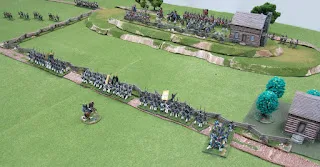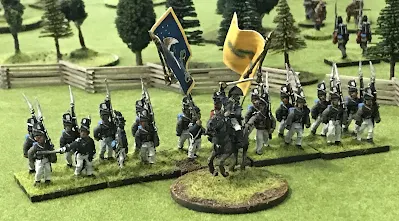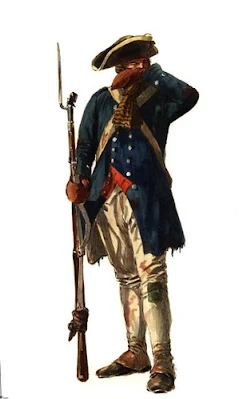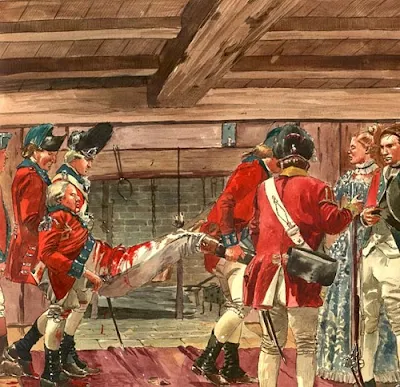Aly Morrison wrote in the comments on my last post, "Are you going to play Lundy's Lane next...?" To quote Lt. Colonel Miller, " I'll try sir."
This is a battle that has fascinated me for a very late by time. It was the largest and bloodiest battle fought in Canada during the war. I have walked what is left of the actual field. My library had numerous papers , articles and books about it. But I have not as yet fought it on my table top.
Probably because it was a such a confusing affair. Confusing from its order of battle, and because the major fighting occurred in the dark. And how does one portray Winfield Scott standing his brigade under artillery fire for an hour wasting his ammunition during at artillery over four hundred yards away? This is going to take some work on my part and advice from you. What I am trying here for is not a simulation of the fight down to every little detail. But a game based on the battle that will give you the flavor of the action.
Reading material and more:
If your interested in reading about the battle I highly recommend these two books,:
Donald E. Graves. The Battle of Lundy's Lane: On the Niagara in 1814. (reprinted in paperback under a new title : Where Right and Glory Lead! The Battle of Lundy's Lane, 1814)
And
Richard Feltoe. A Crucible of Fire: The Battle of Lundy's Lane, July 25, 1814 (Upper Canada Preserved ― War of 1812)
There are two very good book on the battle which I highly recommended. Both are outstanding and go a long way to unravel the mysteries of the controversial battle.
Donald E. Graves is the dean of scholars on battles in Canada during the War of 1812. His scholarship is first class and his books all must have. Unfortunately his book is out of print and sometimes difficult to obtain.
Richard Feltoe's book is less well known then Graves' book but is equally well done. In addition it has a large number of maps which makes following the battle much more easier. I used thus book on my battlefield walk for Lundy's lane and it was if great help. In addition there is a Kindle version of the book available for those who must have it right away.
Terrain and topography:
The battlefield included a very large steep hill, woods, a small grave yard and fence lined roads. There were a couple very small buildings but they played no part in the fight. Here are two detailed maps of the battle for those who wish to get every little detail correct.
On the other hand here is a very nice wargame table set up of the battle. This comes from Forrest Harris of Knuckleduster miniatures and is the setup for his version of the battle. I personally like it a lot and will be striving for something like this. Almost all of my miniatures by the way are by knuckleduster miniatures. They are excellent and Forrest is a true gentleman to work with.
Time and Darkness:
The battle lasted for six hours. It started about 6:00 PM and ended a little after midnight. During that time Scott held his Brigade under artillery fire for an hour, reinforcements arrived, and darkness obscured the action. Regiments got lost and other regiments blundered into each others. Sadly there were numerous examples of friendly fire. Oh! And Winfield Scott returned to the battle and marched what was left of his Brigade between both sides in the dark. And yes, both sides fired on them. Scott was badly wounded ( IMHO it was one of his own men who did it) and left the field while his brigade was destroyed.
So, how to portray on the table gradual darkness? How many inches away in the dark should you be able to see? If short range for muskets is say 4" what is visibility? I was thinking for muskets in the dark no matter how close you are use long range to simulate the effect of darkness. Regiments missed their way and got lost or blundered into each other. How to portray that! And if course friendly fire because it did happen. I am looking for advice here and how others have tackled these problems in their games.
Conclusion:
These are my thoughts and I am looking forward to hearing your advice. I will be posting my order of battles soon to give you an idea of the armies involved.

.jpeg)



























.jpeg)



.jpeg)
.jpeg)












%20(2021-07-01T13_23_10.000)_kindlephoto-17615437.jpg)
%20(2021-07-01T13_23_10.000)_kindlephoto-17636438.jpg)